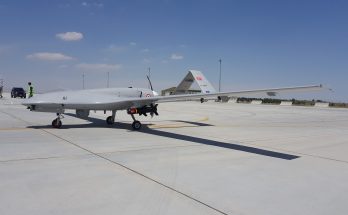by Daniel Darling, Military Markets Analyst, Forecast International.
The Indian Defense Ministry has awarded the partnership of local engineering prime Larsen & Toubro (L&T) and South Korea’s Samsung Techwin with a contract worth $750 million (INR48.71 billion) for 100 K-9 Vajra howitzers. The K-9 consists of a 155mm, 52-caliber howitzer mounted on a tracked vehicle, providing it with the necessary mobility to maintain pace with the Indian Army Mechanized Strike Corps’ T-90S tanks.
The contract is noteworthy in that the Indian Army has long suffered field artillery issues that successive governments and the Defense Ministry have failed to address since 2000 when a Field Artillery Rationalization Plan (FARP) was introduced. The FARP came into being following the 1999 Kargil War with Pakistan and Pakistan-supported Kashmiri militants. During this conflict it became clear to Indian military planners the necessity of fielding adequate artillery, whose utility in softening entrenched enemy positions and destroying logistical networks proved invaluable. With its ranks having gone without a new artillery type since the controversial 1986 purchase of the Swedish Bofors FH-77, the Army pressed the need to begin overhauling its artillery inventory with upgraded and modernized pieces.
The FARP was meant to address this requirement and called for purchases of 3,000 to 3,600 155mm howitzers in two calibers (39 and 52) that would come in towed, mounted and self-propelled (both wheeled and tracked) forms. These would be both imported and license-produced locally, cost a total of $5-7 billion, and all be delivered by 2027 (which will mark the end of the Army’s 14th Five-Year Finance Plan).
But through 2014, the plan remained dragged down by bureaucratic delays, the issuing and re-issuing of tenders (a common Indian practice), failed and inconclusive trials, and unfeasible Qualitative Requirements issued by the Artillery Directorate.
Now, however, there finally appear to be small slivers of light in an otherwise murky picture.
First, initial tests on the locally upgraded Dhanush 155mm/45-caliber towed howitzer – a knockoff of the Bofors FH-77B 155mm/39-caliber guns purchased in 1986 – proved successful and have now progressed to the confirmatory trial stage.
Secondly, the Defense Ministry finally gave clearance, on May 13, to the long-stalled acquisition of 145 M777 155mm light howitzers from the U.S. subsidiary of BAE Systems. This program had previously been pushed to the right because of questions involving costs and non-compliant offset proposals. Once delivered, these guns will be operated by Indian Army troops deployed in the high-altitude areas of Arunachal Pradesh and Ladakh on the border with China.
Added to these potential acquisitions is the K-9 Vajra self-propelled howitzer, which cleared Indian Army trials conducted in 2013 and 2014. The K-9 was downselected from a field of competitors under a 155mm/52-caliber self-propelled tracked howitzer competition that saw two earlier attempts to move the project forward in 2006 and 2007 frustrated by corruption charges (against Denel in the initial bid) and the blacklisting from the Indian market of potential vendors. The third tender, issued in 2011, ultimately pitted the K-9 against the Russian 2S19 MSTA-S mounted on a T-72 tank chassis offered by state arms export agency Rosoboronexport.
The Indian contract for the 155mm, 52-caliber self-propelled tracked howitzers falls under the “Buy Global” procurement category, meaning the Indian Defense Ministry would make a direct purchase from a foreign vendor of an off-the-shelf hardware type.
Indian defense offset requirements stipulate that any foreign vendor agreeing to a contract over INR3 billion ($46 million) must provide 30 percent return to the local market in direct offsets, and Samsung Techwin’s partnership with L&T clears this hurdle. The partnership ensures that L&T will perform in-country work on up to 50 percent of each K-9 howitzer platform, including the fire control system, ammunition-handling system, muzzle velocity radar, and nuclear-biological-chemical (NBC) system. In addition, L&T – which struck up a partnership with Samsung Techwin in 2007 – will receive additional work share through maintenance, repair and overhaul of the guns through their 30-40 year service lives.
The Indian Army requirement for the K-9 Vajra is ultimately expected to grow beyond the initial 100 guns to a total of 250+ systems.
For 50 years, Forecast International intelligence reports have been the aerospace and defense industry standard for accurate research, analysis, and projections. Our experienced analysts compile, evaluate, and present accurate data for decision makers. FI's market research reports offer concise analysis of individual programs and identify market opportunities. Each report includes a program overview, detailed statistics, recent developments and a competitive analysis, culminating in production forecasts spanning 10 or 15 years. Let our market intelligence reports be a key part of reducing uncertainties and mastering your specific market and its growth potential. Find out more at www.forecastinternational.com




